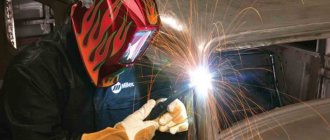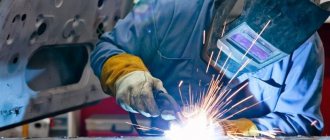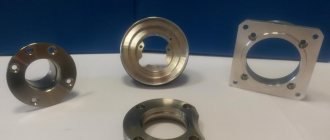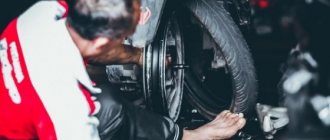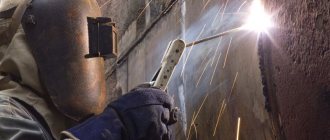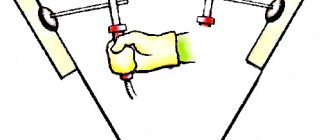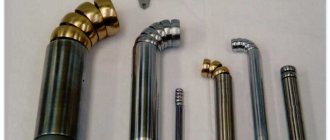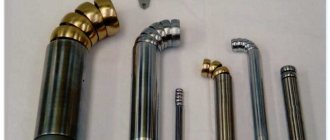Wear of mechanical elements occurs unevenly. In this case, due to damage that is small compared to the size of the part, its performance is lost. Accordingly, the functioning of the unit or even the entire mechanism deteriorates or stops. Among the methods of metal restoration, restoration of parts by welding and surfacing is in first place in terms of prevalence. There are two main reasons:
- Restoring the original properties of the element.
- Relatively cheap.
In the article we will focus on the practical application of restoration techniques in relation to body welding work on cars and trucks.
What does the repair involve?
The processes of welding and surfacing are fundamentally different . In the first case, the melt is used to join the parts. In the second, it acts as a working layer, which is applied to the surface of the part in order to restore its original dimensions.
There are situations when these functions coincide. An example is the restoration of the underbody of a car damaged by corrosion. At the same time, severely damaged areas are replaced with sheets of metal, cracks and holes are restored by surfacing.
In other cases, the wear on the axle or frame of the body part is completely restored by surfacing . At the same time, welding can be used to repair (for example) a crack on the same element.
Another example: welding a truck frame. Here, the elements of the supporting frame where cracks have arisen are welded, and the excavations in the eyes and grooves for fastening units, rods, axles, etc. are welded.
As for iron wear, choosing repair by surfacing is not always advisable . If an automobile plant produces the necessary components, repairs may come down to cutting out the worn part and then welding a new one.
As a rule, welding of a car body is used more often than surfacing on its parts. The reason is the nature of wear caused by the similarity of causes of damage during operation.
It doesn’t matter what brand it is: a VAZ 2109, a Hyundai Porter truck, a Lexus or an old Niva - the majority of body damage is due to corrosion and deformation of sheet metal during accidents.
Semi-automatic machines for surfacing in shielding gases
Semi-automatic PDG-603 (Fig. 6, a) is intended for mechanized arc welding and surfacing in a shielding gas environment, as well as self-shielding flux-cored wire of products made of low-carbon and structural steels. The semi-automatic machine has smooth control of welding parameters, the setting of three independent welding modes, a feed attachment with four
driving gear rollers, a remote control panel, as well as water cooling of the torch when welding at maximum conditions.
Rice. 6. Semi-automatic machines for arc welding and surfacing in shielding gases : a – semi-automatic PDG-603; b – semi-automatic “Midicom-160”
The semi-automatic machine PDGO-501-1 is designed for semi-automatic welding and surfacing of metal with a consumable electrode both in a protective gas environment and with flux-cored wire. The wire feed speed is adjustable in steps from 95 to 725 m/h, wire diameter is 1.2...3.2 mm. The semi-automatic machine is placed on a light trolley along with a device on which a coil of electrode wire weighing up to 80 kg can be placed. The semi-automatic welding kit may include:
- power supply VDG-506 with arc voltage regulation from 18 to 50 V;
- torch for current up to 300 A for welding in a shielding gas environment;
- torch with a current of up to 500 A for welding with flux-cored wire;
- welding wires and control cable with a range of 10 m. Semi-automatic “Midicom-160”. , Russia. Small-sized semi-automatic welding “Midicom-160” (Fig. 6, b) is designed for manual arc welding on direct current with a consumable electrode in a shielding gas environment
low-carbon, alloy, and stainless steel with a total thickness of up to 4 mm. Can be used to perform a variety of welding and installation work in car repair and construction. The semi-automatic device consists of a power transformer, a rectifier and an LC filter of welding current, an electrode wire feeder with a reel and a flexible working hose, a shielding gas supply device, an electronic control unit, a selection of operating modes and indications, and a forced cooling system.
The semi-automatic MIG 305 C/S is used for welding metals of any thickness and chemical composition with solid or flux-cored wire in shielding gases.
Technical characteristics of the semi-automatic device
- Current 40…300 A
- Mains voltage 3380 V
- Current at duty cycle = 35% 285 A
- Current at duty cycle = 60% 215 A
- Current at duty cycle = 100% 170 A
- Open circuit voltage 16…47 V
- Number of voltage adjustment stages 20
- Weight 130 kg
The most favorable conditions for the formation of a metal bead are observed during surfacing in inert monatomic gases argon and helium (Fig. 7). In argon, there are two types of metal transfer through the arc: large-droplet transfer without short circuits with slight spattering at a subcritical current and jet transfer at a current greater than the critical value. The type of metal transfer through the arc gap affects the form of penetration of the base metal and the formation of the deposited bead. Surfacing with jet transfer of electrode metal is undesirable, since this significantly increases the depth of penetration of the base metal.
In helium, droplet transfer is observed with short circuits of the arc (low current and voltage) and without short circuits at increased current and voltage with slight spattering of the electrode metal.
Rice. 7. Scheme of the surfacing process with electrode wire in an argon environment : 1 – welded product; 2 – burner; 3 – electrode wire; 4 – shielding gas; 5 – gas nozzle; 6 – welding arc; 7 – weld pool; 8 – weld bead; 9 – protective atmosphere
A bead of metal deposited in a helium environment has less convexity than in argon, since argon increases the surface tension of the liquid metal. The use of an Ar+He mixture allows you to take advantage of the advantages of both gases.
Equipment used
With all the variety of work methods and tooling, the classification of welding during car repairs comes down to only two types:
- Electric, mainly arc using shielding gases or fluxes.
- Gas, using acetylene or propane.
Electric is divided into manual, semi-automatic in an inert gas environment, submerged, etc.
There are other methods, such as laser, friction, and diffusion welding. However, they are practically not used for car repairs.
In some cases, a type of welding is used, such as soldering . It is used to repair damage to pipes made of non-ferrous metals, radiator blocks, and parts of refrigerator equipment made of thin copper.
Which welding is best for welding a car body depends on the nature of the damage, as well as the characteristics of the place or part that needs to be restored.
Today, the majority of work is carried out using electricity. Gas welding, which was once almost the only method of repair, is today used to connect parts made of thin metal.
In addition, oxy-acetylene welding is still popular where various rods that create dynamic loads are attached to the body .
Electrical appliances for small repairs include car welding using an inverter or a conventional manual welding machine. For delicate work that requires high quality, as well as surfacing, semi-automatic machines with carbon dioxide or inert gas are used.
With the spread of aluminum and titanium alloys, the arsenal of repair mechanics was replenished with arc welding devices using a non-consumable electrode in an inert gas environment. With feeding of the melting filler rod by hand or automatically.
Mechanized arc surfacing methods
When choosing an arc surfacing method, it is necessary to take into account such important parameters as the characteristics of the material of the part intended for restoration, the physical and mechanical properties of the deposited coating, the geometric parameters of the workpiece, the level of wear and some others.
There are two types of mechanized welding (surfacing) - automatic and semi-automatic. In the first case, there is a mechanical supply of both electrode consumables (ribbons or wires) into the processing area, as well as relative movement of the part and the electrode. In the semi-automatic welding method, only the electrodes are moved mechanically. The electrode wire is supplied through a hose to the holder, which is moved by the welder himself along the required path manually.
To perform work using the automatic arc surfacing method, the following basic equipment is required: a welding head, a lathe or special machine, a power source and a hardware box.
The design of the welding head (automatic) consists of a feed mechanism for tape or electrode wire (traction rollers are most often used) with blocks for adjusting the speed of feed, lowering, raising, and turning the head.
Some models of surfacing installations, in addition to a device for supplying the electrode to the workpiece, are equipped with a mechanism that produces transverse vibrations of the electrode, which makes it possible to obtain a much wider deposited layer in one pass. This helps improve productivity and seam quality.
Part preparation requirements
The quality of restoration largely depends on how correctly we prepare the part . This applies to welding, and especially surfacing.
The metal is thoroughly cleaned of rust using an angle grinder (angle grinder), better known as an “grinder.” Or with a hand brush. If necessary, chamfer or level.
In critical cases, during surfacing and soldering, the surface is degreased.
Sandblasting or waterjet treatment gives a good effect..
The cracks are cut with angle grinder grinding discs to the full depth to obtain V-shaped grooves in their place. Thick metal is processed on both sides. At their ends, to eliminate stress and prevent further development, through holes with a diameter of 4-6 mm are drilled.
Before fusing the holes, their edges are countersunk on one or both sides; if there is a thread, it is drilled out.
Considering that welding a car with an electrode or gas flame creates a high temperature, care should be taken to ensure the safety of adjacent finishing elements, electrical components. equipment, plastic parts.
To do this, remove the element being repaired or parts that may be damaged. If this is impossible for some reason, measures are taken to protect them (close them, cover them with wet rags).
Other recovery methods
Alternative recovery methods are also popular:
- Vibro-arc surfacing differs from conventional electric welding in that the electrode, in addition to translational movement, performs perpendicular oscillations with a frequency of 90 - 100 beats/sec. During the process, the metal is transferred in small drops into a small weld pool. This achieves a low penetration depth and high adhesion strength of the electrode material to the metal of the part.
- Flame surfacing is carried out by heating the base metal and filler wire with a jet of ionized gas directed into the working area by a torch nozzle.
- Electrical contact surfacing is performed by plastic deformation after heating the metal of the part and the filler material with a pulsed current. It is characterized by high productivity (up to 150 cm²/min), low thermal impact, and low melting.
Surfacing (welding) methods that have passed experimental testing are considered promising:
- electron beam;
- high frequency current;
- laser;
- impregnation of composite alloys;
- explosion;
- self-propagating high-temperature synthesis.
Electrodes used
The selection of electrodes or welding wire is carried out based on three parameters:
- Type of metal.
- The required thickness of the part or surfacing layer.
- The level of responsibility of the part being restored.
When performing body repairs semi-automatically with carbon dioxide, flux-cored welding wire, copper-plated or plain, is used.
Surfacing of a layer with high hardness characteristics is carried out using electrodes of the T-620 type, with a thick coating including graphite, boron carbide, etc.
The required diameter of the electrode is selected based on the thickness of the metal being welded, according to special tables.
Aluminum parts are connected by gas (oxyacetylene) or arc welding. In the latter case, OZA-2 type electrodes are used. When using technology with a non-consumable tungsten electrode, a rod of the corresponding aluminum alloy is used as an additive.
When surfacing worn engine parts to obtain alloyed coatings, wire of the Np-65 type with a high carbon content is used. Work is carried out under submerged arc, in an environment of inert gases.
Application experience.
Currently, we have accumulated extensive experience in restoring parts by surfacing and welding in the process of repairing equipment at enterprises in various industries.
Here are some examples from mining companies:
1) Excavator bucket repair
The bucket, being a replaceable component of an excavator, is subjected to intense mechanical and shock-abrasive loads during operation and needs to be replaced more often than any other component. Using repair technologies, individual parts of the bucket are replaced, as well as subsequent additional armoring of the most loaded fragments. Materials used: Capilla 51 Ti, CrNiMo, E-7018 electrodes, for armoring – Capilla 54 W electrodes or DT-DUR 609 wire. Durability after repair is up to 2-3 years, armor durability – 1 year.
2) Repair of excavator bucket rocker arm
Typical defects are cracks and wear of the lugs. Materials are selected depending on the steel grade, most often Capilla 51 T and E-7018 with welding of additional linings. Eyes - surfacing E-7018 and boring on a boring complex WS-3. Guaranteed durability for at least 1 year.
3) Repair of the working body of an earthmoving machine
Restoration of the working crown by surfacing. Surfacing and grinding are done manually. Materials: Capilla 53 type electrodes. The durability of repaired elements depends primarily on the soil, but is no worse than new ones.
4) Restoration of grab gripper by surfacing
The nature of wear is breakage (broken) or abrasion of the paw tips. Surfacing can be done with or without a prosthesis, depending on wear. Material: Capilla 54 W type electrodes, surfacing is carried out in 3-4 passes. Durability of restoration up to 1 year.
Methods for welded repair of car and truck bodies
A variety of technologies are used to weld the body of both passenger cars and trucks. Fundamentally, they all boil down to an electric arc or a hot gas stream, but at the same time they often have significant technological differences.
Manual arc
Both AC and DC devices are used for work . The first include welding transformers of various types. The latter are represented by welding machines and generators.
The transformer produces an unstable arc and requires significant current across the diameter of the electrode (this characteristic is called current density). At the same time, the temperature of the arc increases, which is fraught with burnout and overheating.
This danger was relevant for old welding transformers, and even now the question: is it possible to weld a car with electric welding does not always give a positive answer. At a minimum, if we are talking about homemade devices or ordinary welding transformers.
The situation has changed with the advent of inverter devices, but this type of connection is used to a limited extent for connecting elements made of thin metal.
As a rule, this method is used to repair massive parts, such as frames or assemblies made of thick metal, for example, mufflers.
A. Tarkhomov, a welder with 20 years of experience: “With a modern inverter, the body can be welded in most cases. Of course, with a professional level device. Everything depends on the welder. A non-specialist should absolutely not do such things.”
Automatic submerged surfacing
It is used quite widely for repairing industrial equipment, especially unique ones. For automotive repairs, the distribution is usually small, for restoration by surfacing of rotating parts (for example, a camshaft) .
The meaning of the method is that the welding arc does not burn openly, but under a layer of special powder - flux. It protects the metal from oxidation and combination with air nitrogen. The quality of the weld or surfacing layer is not inferior to the original metal, and when using special electrodes it can exceed it in hardness and wear resistance.
Vibro-arc method
Like submerged arc surfacing, it is used exclusively in factory conditions, since it requires bulky installations that ensure accurate positioning of the part.
The meaning lies in the oscillatory movements of the melting electrode with a frequency of 100-120 Hz, at a voltage of 12-18 Volts. In this case, surfacing is performed with tiny particles of metal with simultaneous cooling.
In gas protective environments
A method that gives the highest quality results in service stations and repair shops.
Welding or surfacing is carried out in an inert gas environment using a non-consumable electrode (TIG), or with a fusible electrode surrounded by an inert or active gas (MIG/MAG welding, respectively).
Allows you to obtain a connection that is not inferior to that made in the factory . But most importantly, with the help of this method, for the first time, current repairs of parts made of titanium and aluminum alloys and high-strength alloy steels became available to motorists.
Semi-automatic methods
One of the most popular methods used today by small workshops and private craftsmen .
The process is carried out in air or under carbon dioxide. Welding wire of the required composition is used as a consumable electrode. It is served by unwinding from the reel as needed.
Moreover, even household-level devices are capable of automatically adjusting the wire feed speed depending on the arc strength.
Alternative Pressure Recovery Technology
To restore parts under pressure, surfacing or welding is not required. The part is only preheated to plasticity.
The meaning of the method is to change the geometric dimensions of parts during their deformation. There are three main methods:
- draft;
- compression;
- casing.
In the first case, when cylindrical parts such as bushings are compressed, the internal diameter decreases with decreasing height. By crimping, I reduce the lateral deformations of the part, and when casing, on the contrary, they increase it (see picture photo 
In some cases, such operations are supplemented or preceded by surfacing.
Hardening surfacing and repair of parts
Hardening surfacing protects parts from various types of wear, giving the surface of the part specific properties. Hardening surfacing is used in the repair of worn parts. and in the manufacture of new parts.
The required properties of parts are obtained by applying a metal layer to their surface, which provides good wear resistance. The application of reinforcing layers can be carried out using various welding methods. Increased hardness does not always mean good wear resistance and increased product life.
The number of deposited layers can also affect the hardness level and significantly influence the ability to resist wear.
Wear factors
There are a large number of wear factors that appear both in pure form and in combination with each other. Therefore, to ensure maximum hardening efficiency, the filler metal must be carefully selected.
The grade of reinforcement metal should be selected as a compromise between each wear factor. Therefore, when the wear mechanism is studied, it is determined which factor is the main one and which is the secondary one.
Experience shows that in order to select the optimal metal for hardfacing, you need to know the following:
1. what are the main factors of wear; 2. what grade of base metal of the part being hardened; 3. what welding methods are preferable to use;
4. what final machining of the part is required.
If the primary wear factor is abrasive wear and the secondary wear factor is impact wear, then the reinforcing metal should be used such that it has good resistance to abrasive wear as well as sufficient resistance to impact wear. To simplify the general understanding of wear factors, they can be divided into characteristic types.
Metal-on-metal friction wear or adhesive wear
This type of wear occurs when one part rubs against another, for example: when shafts rotate in bearings, when sprockets come into contact with chains, when a pair of gears operates, etc.
Martensitic alloys resist metal-to-metal wear well. Austenitic-manganese and cobalt alloys also resist this type of wear well.
Cobalt alloys are used for parts operating at high temperatures and in oxidizing environments.
Typically, contact between surfaces of materials of the same hardness produces excessive wear. Therefore, materials of different hardness are chosen for the friction pair.
Impact wear
Metal parts are deformed, partially broken and even completely destroyed if their surfaces are not protected from impact wear.
Impact wear occurs in crushing and grinding equipment where rock or gravel is crushed.
In this case, small abrasive particles are formed, so the surfaces of the equipment must be simultaneously protected from abrasive wear.
Austenitic-manganese steels, when surface hardened, offer great resistance to pure impact wear due to their high surface hardness and relatively soft core.
Martensitic alloys also resist moderate impact wear, but to a lesser extent than austenitic-manganese alloys.
Crusher plates, impact hammers, railway crosspieces and rails are subject to intense impact wear.
Abrasive wear caused by small mineral particles
This type of wear occurs when sharp particles slide across a metal surface at varying speeds. Wear occurs by grinding down the metal with particles that are like small cutting tools. The heavier the particle and the sharper its shape, the more severe the abrasion.
This type of wear occurs in earth-moving equipment, agricultural tools, and when transporting minerals. Due to the absence of shock loads, brittle high-carbon chromium steels and carbide-containing alloys are excellent at resisting this type of wear.
Intense abrasive wear in the presence of pressure
This type of wear occurs when small, hard abrasive particles are crushed and ground between two metal parts.
Typical parts subject to this type of wear are nozzles, rotary crushers, mixer blades, and scraper blades. To strengthen such parts, austenitic-manganese, martensitic and carbide-containing alloys are used.
Carbide alloys usually contain small titanium carbides, evenly distributed throughout the volume, which resist this type of wear well.
High temperature wear
When metals are exposed to high temperatures for long periods of time, they tend to lose strength. As a result of operating at high temperatures, thermal fatigue cracks appear.
Thermal shock caused by cyclic thermal stresses is observed in forging and hot working tools and dies. When working in an oxidizing environment, the metal surface is covered with an oxide film, which is destroyed upon cooling and the oxidation process is repeated.
Martensitic steels containing 5-12% chromium have good resistance to thermal fatigue wear. Alloys with chromium carbides offer excellent wear resistance at temperatures up to 600°C. To operate at elevated temperatures, nickel- or cobalt-based alloys are often used.
Rolling rollers, dies, guillotine knives, punches, dies for hot metal processing, etc. operate at high temperatures.
Base metal
There are two main groups of metals that undergo hardening surfacing: carbon and low-alloy steels; austenitic-manganese steels. A magnet can be used to differentiate between these materials. Carbon and low alloy steels are magnetic.
Austenitic-manganese steels are not magnetic. Once hardened, however, these steels become magnetic.
Recommendations for welding these steels are completely different. Thus, the carbon content and alloying elements in carbon and low-alloy steels require preheating, slow cooling and subsequent heat treatment.
Austenitic-manganese steels must be welded without heating and subsequent heat treatment. The temperature of parts made of austenitic-manganese steels during surfacing should be no more than 200°C, since these materials become brittle when overheated.
Arc welding methods used in surfacing
The most common welding methods used in hardfacing are described below.
Manual arc welding with coated electrodes, SMAW
- allows for surfacing of large areas;
- is a relatively inexpensive welding method;
- is a universal method that allows for hardening surfacing in the open air and in various spatial positions.
Flux Cored Arc Welding, FCAW
- allows for hardening surfacing on various parts;
- has high performance;
- can be used in field conditions due to the possibility of open arc welding;
- When welding with self-shielding wire, there is no need to use shielding gases.
Submerged arc welding, SAW
- performed only in the down position;
- has a high deposition rate;
- allows you to restore long-term worn surfaces;
- characterized by the absence of metal spattering and the absence of light radiation when the arc burns.
Final machining of parts hardened by surfacing
The machinability of the hardened surface is determined by the type of weld metal being deposited, as some can be easily machined and some cannot be machined at all.
In addition, many high-alloy weld deposits result in “ridge cracks,” which form across the weld metal as it cools and can affect the base metal.
Therefore, before selecting hardfacing materials, the following questions should be answered: Is turning after welding required or is grinding preferable? Are raised cracks acceptable?
As a rule, if the hardness of the weld metal is less than 40 HRC, then turning is possible. If the hardness is more than 40 HRC, then grinding is necessary. Relief cracks often do not have a detrimental effect on the quality of the surfacing and do not cause chipping of the metal and destruction of parts.
However, if parts are subjected to intense bending loading, it is necessary to apply ductile buffer layers before hardening to prevent the development of cracks in the base metal.
The probability of appearance of relief cracks increases at low values of welding current and high welding speeds.
Types of surfacing materials
Surfacing materials can be divided into groups according to their characteristics, properties and wear resistance:
Iron-based metals:
- martensitic steels;
- austenitic steels;
- alloys with a high content of carbides.
Metals based on other metals:
- cobalt-based alloys;
- Nickel-based alloys.
The properties of the listed surfacing materials are as follows:
Austenitic:
- have excellent resistance to impact wear;
- well suited for restoring the geometry of worn parts;
- have good resistance to abrasive wear.
Martensitic:
- used to restore the geometry of worn parts and for hardening surfacing;
- have good wear resistance when rubbing metal against metal;
- have good resistance to impact wear;
- have good resistance to abrasive wear.
Alloys with high carbide content:
- have excellent resistance to abrasive wear;
- have good thermal resistance;
- have good corrosion resistance;
- characterized by low resistance to impact wear.
Cobalt and nickel based alloys:
- resists most types of wear well;
- characterized by low resistance to impact wear;
- due to their high cost, they are used when alloys with a high carbide content do not provide the required wear resistance; Nickel alloys are less expensive than cobalt alloys.
See also:
2 Electric arc restoration surfacing with coated electrodes
This type of surfacing procedure is considered the most common. Such surfacing demonstrates excellent results not only on industrial scale, but also at home. It is very convenient and simple, and most importantly, you do not need to purchase any special equipment.
When using electric arc restoration, it is important to choose the right electrode so that it can form a surfacing layer with the required parameters. The cross-section of the rod determines the shape and thickness of the part to be processed, and the specific type of electrode is selected depending on the composition of the deposited metal.
In most cases, steel products are restored using the method discussed in the article in the lower position of the electrode using a current of reverse polarity. In this case, it is imperative to prepare the base metal for the procedure by cleaning its surface from rust, oil residues and other contaminants.
Restoration of shafts made of low-alloy and low-carbon steels is most often carried out without heating them. But parts made from other grades of steel are often heated (preliminarily), and then internal stresses are removed from them by heat treatment. Preheating temperature - from 300 degrees.
Surfacing welds can be positioned in different ways. When cylindrical products are processed, three main schemes are used:
- the rollers run along a helical line;
- closed circular rollers;
- rollers along the generatrix.
The first method is considered optimal in cases where surfacing is carried out mechanically.
When working with flat surfaces, there are two common schemes that involve use:
- wide rollers (the movement of the electrode in the transverse direction is increased);
- narrow rollers (they overlap each other by about a third of their width).
Restoration of “special” parts by welding and surfacing (for example, structural elements operating under increased loads, measuring and cutting devices) can be carried out using hard alloys rather than ordinary metal. Such alloys usually contain compounds of nickel, cobalt, boron, iron, carbon with chromium, tantalum, titanium, and manganese.
If these products have a high wear rate, preliminary surfacing is performed before the main surfacing using welded rods made of steel with a low carbon content. But in those cases when new cutting and measuring devices are manufactured with carbide-type surfacing, the basis for them is blanks made of alloy and carbon steel grades.
Restoration of a special tool is usually performed using the following types of electrodes:
- CI-1M;
- OZI-5 (3, 6);
- CS-1.
But parts operating in difficult conditions are fused with rods T-620, OZN-300M, T-590, OZN-7M, OMG-N.
Features of restoring cast iron parts
The difficulty of restoring cast iron parts is due to the fact that when the seam cools quickly, it becomes excessively brittle, since a lot of carbon remains in the metal. Since the materials of the parts and seams have different shrinkage coefficients, cracks form during and after welding. At high temperatures, carbon and silicon burn out to form slag and gases, which, upon rapid cooling, remain inside the seams in the form of pores and inclusions.
To obtain strong, uniform seams, restoration is performed by hot welding. The part is preheated slowly to 650 - 700⁰C for 1.5 - 2 hours in an oven. Then transfer it to a thermos so that the temperature during operation does not fall below 500⁰C. Welding or applying a layer is carried out through the hatch. After restoration is completed, the part is annealed at 600 - 650⁰C in an oven or thermos. The instructions recommend reducing the temperature at a rate of 50 - 100⁰C/hour.
Note!
If repairs are performed with a gas burner, cast iron rods are used as filler material.
Electric welding is carried out with cast iron electrodes coated with up to 50% graphite. Due to low productivity and complexity of equipment, this method is rarely used.
Restoration by cold welding is performed without preheating. Therefore, measures are taken to prevent deformation and the formation of defects. A gas burner melts cast iron slowly, but without overheating. Electric welding is carried out with direct current of reverse polarity, the diameter of the electrodes is 3 - 4 mm. When surfacing, beads are applied scattered in sections of 40 - 50 mm. Before starting the next one, the previous seam is cooled to 50 - 60⁰C.
Depending on the tasks being solved, filler rods and electrodes are used for cold welding:
- cast iron;
- steel;
- combined;
- bunched;
- monel;
- copper-steel.
When restoring parts, it should be taken into account that, regardless of the surfacing method, the deposited metal will be heterogeneous in mechanical parameters, structure, and chemical composition. Therefore, if the part operates under heavy loads, it is recommended to replace it with a new one.
